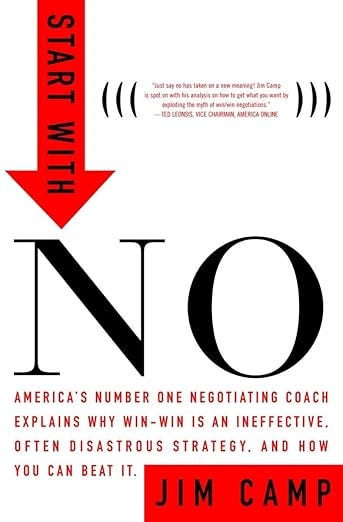Think a win-win solution is the best way to make the deal? Think again. For years now, win-win has been the paradigm for business negotiation. But today, win-win is just the seductive mantra used by the toughest negotiators to get the other side to compromise unnecessarily, early, and often.
Start with No offers a contrarian, counterintuitive system for negotiating any kind of deal in any kind of situation—the purchase of a new house, a multimillion-dollar business deal, or where to take the kids for dinner.
Start with No introduces a system of decision-based negotiation that teaches you how to understand and control these emotions. It teaches you how to ignore the siren call of the final result, which you can’t really control, and how to focus instead on the activities and behavior that you can and must control in order to successfully negotiate with the pros.
The best negotiators:
Aren’t interested in “yes”—they prefer “no”
Never, ever rush to close, but always let the other side feel comfortable and secure
Are never needy; they take advantage of the other party’s neediness
Create a “blank slate” to ensure they ask questions and listen to the answers, to make sure they have no assumptions and expectations
Always have a mission and purpose that guides their decisions
Don’t send so much as an e-mail without an agenda for what they want to accomplish
Know the four “budgets” for themselves and for the other side: time, energy, money, and emotion
Never waste time with people who don’t really make the decision
Start with No is full of dozens of business as well as personal stories illustrating each point of the system. It will change your life as a negotiator. If you put to good use the principles and practices revealed here, you will become an immeasurably better negotiator.
How to Start with No: Harnessing the Psychological Power of Commitment and Refusal by Jim Camp focuses on a counterintuitive approach to negotiation: starting with rejection and leveraging the power of "no." Here are some big ideas from the book:
1. "No" Is the Starting Point, Not the End
Traditional negotiation teaches you to seek agreement at all costs, but this creates unnecessary pressure. Starting with "no" opens the conversation by eliminating false expectations.
Saying "no" provides clarity and positions you as a decision-maker, setting the stage for genuine dialogue.
2. The Mission and Purpose Rule
Every negotiation should be guided by a clear mission or purpose. Understanding the "why" behind your actions keeps you focused and helps resist distractions or manipulations.
Develop a deep understanding of your counterpart’s needs and fears, aligning your mission with their goals.
3. The Power of Questions
Asking open-ended questions engages the other party emotionally and intellectually. It encourages them to reveal their true concerns, values, and objectives.
Avoid telling or convincing; instead, explore the other party’s perspective to uncover valuable insights.
4. Avoid the Trap of Needing to Say "Yes"
The fear of rejection or conflict often forces people to seek quick agreement, leading to compromises. Let go of the need to hear "yes" and instead build trust through honest exchanges.
"Yes" can sometimes trap you into commitments you’re not prepared for, whereas "no" keeps you free to explore options.
5. Control Emotions and Stay Neutral
Emotional reactions are detrimental in negotiations. The calmer and more neutral you are, the better you can think strategically and respond effectively.
Always separate your emotions from the negotiation and focus on the process, not the outcome.
6. Leverage the Power of Deadlines
Deadlines can be both a strength and a weakness. Recognize when the other party is under time pressure, but avoid letting their deadlines dictate your decisions.
Control the timeline by creating a sense of urgency through your terms, not theirs.
7. Never Split the Difference
Compromising too early or splitting the difference leads to suboptimal results. Always seek a solution that fully aligns with your mission and goals.
Maintain your value and walk away if necessary. Confidence in refusal is a sign of strength.
8. The Power of Preparation
Preparation is the cornerstone of successful negotiation. Map out potential objections, outcomes, and scenarios beforehand.
Always plan for "what if" situations so you remain agile and can adapt without being caught off guard.
9. Understand Their Pain Points
People are motivated by their needs, desires, and fears. Learn what’s driving the other party and frame your proposal as a solution to their problems.
Empathy and understanding build trust, making it easier for them to engage openly.
10. Celebrate "No" as Progress
Every "no" gives you an opportunity to understand what doesn’t work and adjust your approach.
A rejection is not failure but feedback, a chance to improve your offer or strategy.
11. Lead by Serving
Serve the other party’s interests genuinely while maintaining your goals. Negotiation isn’t about overpowering the other side; it’s about creating mutual value.
This book redefines negotiation as a disciplined, thoughtful process where "no" is a gateway to a better "yes." It’s especially relevant for leaders, entrepreneurs, and sales professionals seeking long-term success in deal-making.













Share this post